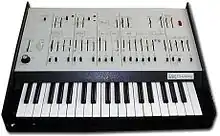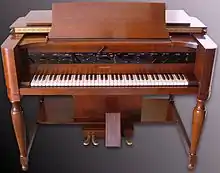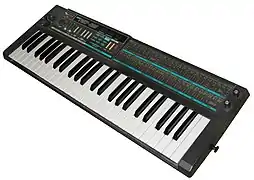Paraphony
Paraphony is a term which has two distinct meanings in the field of music.
In musical theory
Paraphony is a term used in musical vernacular to refer to consonances which rely upon intervals of fifths and fourths. This terminology can be traced to ancient Greece and sources such as Theon of Smyrna.[1]
In electronic music
Completely unrelated to the above sense, a synthesizer is called paraphonic if it can play multiple pitches at once, but those pitches share part of their electronic signal paths.[2] For example, the Roland RS-202 string machine could play several dozen pitches at once, but only with a single shared volume envelope, requiring the collective chord to swell and diminish as a single cohesive whole. Similarly, the Korg Poly-800 had 8 oscillators and could produce 8 voices, but had just one filter circuit shared by all of them. Other examples include the Roland VP-330 vocoder and the Moog Sub 37.


Non-paraphonic polyphony
The following example simulates how we would expect a non-paraphonic polyphonic synthesizer (i.e. one with an individual EG for each voice) to behave when multiple overlapping notes are played without being released. (In this case, C, F# then B).
Note how previously-played (but still held down) notes remain "in the background" when subsequent notes are hit. This is broadly similar to the behaviour we would expect if the same thing were played on (e.g.) a piano.
Paraphonic synthesizer
The above can be contrasted with the following recording of how one paraphonic synthesizer (a Korg Volca Keys) actually handles the same situation in real life.
The first note (C) briefly peaks at a high volume ("Attack") when hit, then fades to a quieter level ("Sustain") as the key remains held down (in accordance with ADSR settings).
When the second note (F#) is played, it similarly comes in at full attack volume. However, due to the envelope generator being shared with the voice playing the (still held-down) C, it is forced to do the same. The 'C' returns to full volume simultaneously, giving the false impression it had been hit again.
When the third note (B) is played, a similar situation occurs. The previously-held C and F# return to full "attack" volume alongside, giving the false impression all three notes were hit simultaneously in a chord-like manner.
(While this demonstrates how the Volca Keys chooses to handle paraphony, other methods for doing so are also possible).
References
- pg. 417 of "Apollo's Lyre: Greek Music and Music Theory in Antiquity and the Middle Ages" By Thomas J. Mathiesen, published by U of Nebraska Press
- "Polyphony, Paraphony and Multitimbrality". 2015-01-08.

